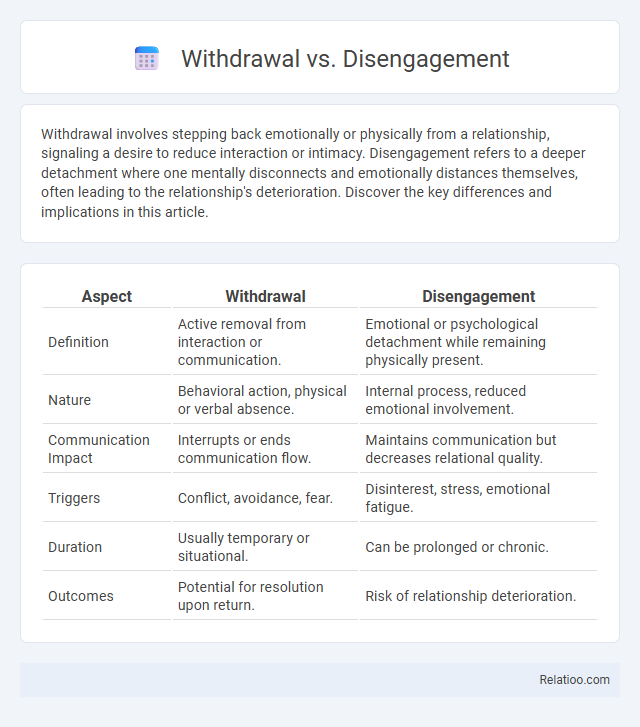Withdrawal involves stepping back emotionally or physically from a relationship, signaling a desire to reduce interaction or intimacy. Disengagement refers to a deeper detachment where one mentally disconnects and emotionally distances themselves, often leading to the relationship's deterioration. Discover the key differences and implications in this article.
Table of Comparison
| Aspect | Withdrawal | Disengagement |
|---|---|---|
| Definition | Active removal from interaction or communication. | Emotional or psychological detachment while remaining physically present. |
| Nature | Behavioral action, physical or verbal absence. | Internal process, reduced emotional involvement. |
| Communication Impact | Interrupts or ends communication flow. | Maintains communication but decreases relational quality. |
| Triggers | Conflict, avoidance, fear. | Disinterest, stress, emotional fatigue. |
| Duration | Usually temporary or situational. | Can be prolonged or chronic. |
| Outcomes | Potential for resolution upon return. | Risk of relationship deterioration. |
Understanding Withdrawal and Disengagement
Withdrawal refers to the physical or emotional retreat from social interaction or participation, often driven by internal factors such as stress or anxiety, while disengagement implies a conscious or unconscious reduction in involvement or interest in activities or relationships. Understanding withdrawal involves recognizing its symptoms, causes, and effects on mental health, highlighting how avoidance may serve as a coping mechanism but also lead to isolation. Disengagement typically indicates a gradual loss of connection and motivation, contrasting with abrupt withdrawal episodes, and requires different strategies for re-engagement and support.
Key Differences Between Withdrawal and Disengagement
Withdrawal refers to a complete removal from a situation or relationship, often leading to physical or emotional absence, while disengagement involves a reduction in emotional involvement without necessarily leaving the context entirely. Key differences between withdrawal and disengagement include the degree of separation--withdrawal implies total exit, whereas disengagement allows for partial presence or minimal interaction. Withdrawal often results in abrupt disconnection, whereas disengagement is a gradual process marked by declining participation and investment.
Psychological Triggers of Withdrawal
Withdrawal, disengagement, and retreat represent distinct responses to psychological stress, with withdrawal often triggered by feelings of anxiety, fear, or rejection that lead your mind to seek safety through isolation. Psychological triggers of withdrawal include overwhelming stress, perceived threats to emotional well-being, and the desire to avoid conflict or negative stimuli. Understanding these triggers allows you to develop healthy coping mechanisms to prevent prolonged isolation and support mental resilience.
Causes and Signs of Disengagement
Disengagement often stems from factors such as lack of motivation, unclear goals, or poor workplace relationships, leading to reduced productivity and emotional detachment. Signs include decreased participation, minimal communication, and diminished enthusiasm towards tasks or team activities. Identifying these symptoms early helps differentiate disengagement from withdrawal, which typically involves complete physical or emotional retreat from the environment or task.
Impact on Mental Health: Withdrawal vs Disengagement
Withdrawal often involves a retreat from social interaction and engagement, leading to feelings of isolation and increased risk of anxiety or depression. Disengagement refers to a psychological distancing from activities or relationships without complete social retreat, which can cause emotional numbness and decreased motivation but may preserve some social support. Your mental health may suffer more severely from withdrawal due to the lack of connection, whereas disengagement might allow partial maintenance of social ties, affecting overall well-being differently.
Social and Workplace Consequences
Withdrawal in social and workplace contexts often leads to reduced communication, lower productivity, and diminished team cohesion, resulting in impaired collaboration and increased isolation. Disengagement manifests as emotional detachment and lack of motivation, causing decreased job satisfaction, higher absenteeism, and elevated turnover rates. Distinguishing withdrawal as a physical or behavioral retreat and disengagement as a psychological disconnection helps organizations implement targeted interventions to improve employee well-being and maintain effective social networks.
Strategies to Address Withdrawal
Withdrawal involves a complete retreat from social or professional interactions, often due to stress or dissatisfaction, while disengagement refers to a reduction in emotional or cognitive involvement. Effective strategies to address withdrawal include fostering open communication, providing psychological support, and enhancing engagement through meaningful tasks that align with Your interests and strengths. Implementing regular check-ins and offering resources like counseling or training can prevent prolonged withdrawal and promote re-engagement.
Techniques to Prevent Disengagement
Techniques to prevent disengagement involve fostering clear communication, setting achievable goals, and encouraging active participation to maintain motivation and connection. You can implement regular check-ins and provide constructive feedback to address concerns before they lead to withdrawal or disengagement. Creating an inclusive environment that values your input supports sustained engagement and reduces the risk of detachment.
When to Seek Professional Help
Seek professional help when withdrawal symptoms become severe, persistent, or interfere with daily functioning, indicating potential substance dependence or mental health issues. Disengagement from social or occupational activities that leads to isolation, decreased motivation, or emotional distress also warrants evaluation by a mental health professional. Addressing these behaviors early with expert support can prevent escalation and promote effective recovery strategies.
Promoting Re-engagement and Social Connection
Withdrawal involves physically or emotionally removing oneself from social interactions, while disengagement refers to losing interest and reducing participation in activities. Promoting re-engagement focuses on encouraging Your active involvement by fostering meaningful connections and tailored support to rebuild social bonds. Emphasizing social connection boosts motivation and combats isolation, enhancing overall well-being and community integration.

Infographic: Withdrawal vs Disengagement
 relatioo.com
relatioo.com